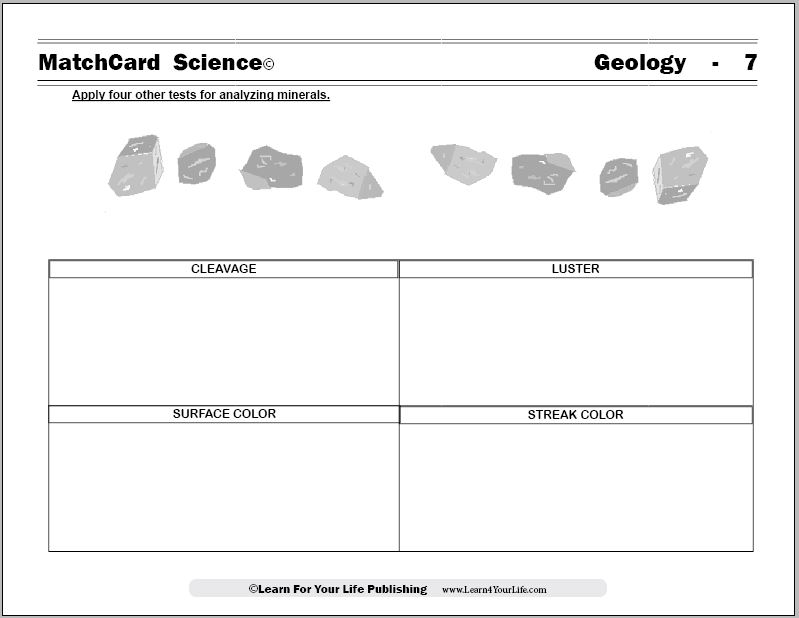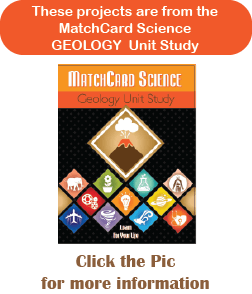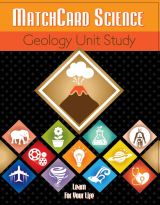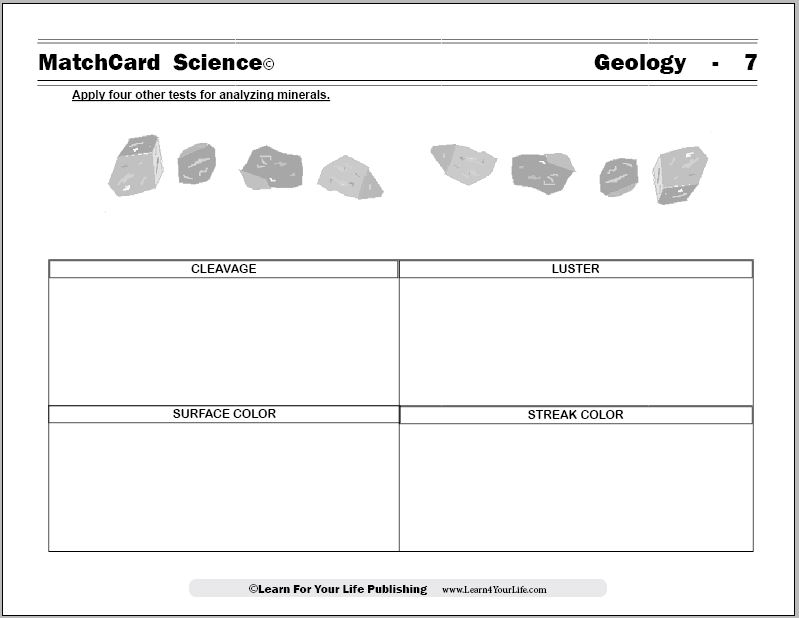Mineral Identification Lab
Investigate the Physical Properties of Minerals
This mineral identification lab guides students in examining the physical properties of minerals.
Free Download Below


MatchCard Science Mineral Identification Lab
Objective: Describe and use tests for identifying minerals.MatchCard: Download below.
The MatchCard has a table with the four tests for the physical properties of minerals. MatchCard Information Pieces describe the tests and give examples. The instructors page gives the correct answers.
Download and Use the Mineral Identification MatchCard
This is MatchCard #6 of the Geology Unit Study. Look below for more information on MatchCards and the MatchCard Science curriculum.Mineral Identification Activity
You will need the following supplies:- Mineral Identification MatchCard and Information Pieces for each student (download below)
- 10 or more minerals to identify
- A small hammer
- A small cloth
- A streak plate of unglazed porcelain (for streak color)
- A Rock and Mineral Field Guide
Teach Mineral Qualities
Before showing the students the MatchCard, show them a mineral and ask them to describe it. Show them the field guide (without opening it) and tell them that if we can describe a mineral we can look up its physical properties to identify it.
Tell them that there are four tests that can be done after the Mohs Hardness test to identify a mineral. Let them brainstorm what physical properties might be used as mineral identification tests.
Give them the copy of the Geology 6 MatchCard as a mineral identification worksheet. They will use this MatchCard in two ways:
- As the lab to identify their assortment of mineral specimens
- As a review of the physical properties of minerals worksheet.
Mineral Hardness
Mineral Identification Lab #1 - Hardness
In the last MatchCard, students practiced using Mohs Test for Hardness as the first step in identifying a rock or mineral.
If you have not done so, you may wish to download and use the Mohs Hardness Test now.
Mineral Cleavage
Mineral Identification Lab #2 - Cleavage
Another one of the physical properties of minerals is cleavage. This refers to the way a mineral divides when it is split.
Minerals will divide in one, two, or three planes. This helps geologists and students identify an unknown mineral.
Use a small hammer and strike the mineral specimen that is being studied. It is advised to cover the mineral with a small cloth, or put into a cloth sock, before striking it with a hammer. This prevents small fragments from flying into someone's eye.
Luster
Mineral Identification Lab #3 - Luster
Another physical property used to identify minerals is the luster of the mineral specimen. Luster refers to the "shiny-ness" of the rock. (Shiny-ness is not actually a word, but students understand it better than luster.)
The rock's luster depends on its ability to absorb or reflect light. Here are some of the terms used to describe luster in a mineral lab:
- Metallic - light reflects off of it as it does metal
- Pearly - has a smooth shine on the surface, somewhat like a pearl
- Adamantine - transparent or translucent, like a diamond
- Waxy - most of the light is absorbed and looks like the surface of wax
- Dull - all light is absorbed, giving no shine
You might wish to review the properties of light with the Refraction, reflection, and absorption Matchcard.
Surface Color of Minerals
Mineral Identification Lab #4 - Surface Color
Another one of the physical properties used to identify minerals is the surface color. With time, impurities may alter the color of the mineral.
Some minerals are always the same color. For instance, sulfur is always yellow.
On the other hand, some minerals may exist with more than one surface color. Having a field guide to compare the specimen being evaluated is necessary.
Streak Color of Minerals
Mineral Identification Lab #5 - Streak Color
This is usually one of kids' favorite activities in identifying rocks and minerals.
Minerals leave a certain color when rubbed on a streak plate. A streak plate is made of unglazed porcelain and is essential as a mineral identification tool.
Streak color is important because minerals that come in different colors still only have one streak color. The color may be different than the color of the mineral.
Mineral Identification Lab #2 - Cleavage
Another one of the physical properties of minerals is cleavage. This refers to the way a mineral divides when it is split.
Minerals will divide in one, two, or three planes. This helps geologists and students identify an unknown mineral.
Use a small hammer and strike the mineral specimen that is being studied. It is advised to cover the mineral with a small cloth, or put into a cloth sock, before striking it with a hammer. This prevents small fragments from flying into someone's eye.
Luster
Mineral Identification Lab #3 - Luster
Another physical property used to identify minerals is the luster of the mineral specimen. Luster refers to the "shiny-ness" of the rock. (Shiny-ness is not actually a word, but students understand it better than luster.)
The rock's luster depends on its ability to absorb or reflect light. Here are some of the terms used to describe luster in a mineral lab:
- Metallic - light reflects off of it as it does metal
- Pearly - has a smooth shine on the surface, somewhat like a pearl
- Adamantine - transparent or translucent, like a diamond
- Waxy - most of the light is absorbed and looks like the surface of wax
- Dull - all light is absorbed, giving no shine
You might wish to review the properties of light with the Refraction, reflection, and absorption Matchcard.
Surface Color of Minerals
Mineral Identification Lab #4 - Surface Color
Another one of the physical properties used to identify minerals is the surface color. With time, impurities may alter the color of the mineral.
Some minerals are always the same color. For instance, sulfur is always yellow.
On the other hand, some minerals may exist with more than one surface color. Having a field guide to compare the specimen being evaluated is necessary.
Streak Color of Minerals
Mineral Identification Lab #5 - Streak Color
This is usually one of kids' favorite activities in identifying rocks and minerals.
Minerals leave a certain color when rubbed on a streak plate. A streak plate is made of unglazed porcelain and is essential as a mineral identification tool.
Streak color is important because minerals that come in different colors still only have one streak color. The color may be different than the color of the mineral.
MatchCard Science
How To Use MatchCards

Download the FREE MatchCard Science Instructor's Guide and see how MatchCards can make building their science knowledge base fun.
Geology Unit Study

12 Science Unit Studies

Chemistry is only one of twelve complete unit studies for kids in 3rd to 8th grade.
Comprehensive objectives, hands-on projects, suggested science fair experiments, and the fun game-like MatchCards keep them interested in learning science. See all twelve MatchCard Science Unit Studies.
About Our Site
Hands-On Learning















